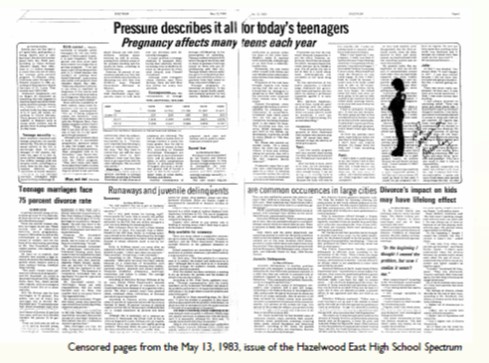Hazelwood court case decision still affects student journalism after 30 years

The two articles that caused the entire court case and helped to start to give student journalists control over their publications back.
Background Information
Hazelwood v. Kuhlmeier was a court case in 1988 over the First Amendment that was not only controversial, but also the event that is giving student journalists control over their publications again.
The case was against the Hazelwood East High School after two articles in the school’s paper, “The Spectrum,” were censored from being published by the principal of Hazelwood.
One of the two topics of the articles was about teen pregnancy and the other article was about how divorce affects children. The principal of Hazelwood had decided that the pregnancy article, in the article the names of the pregnant teens had been changed to protect them, was not going to keep students from figuring out who the girls were.
He also felt that the father of the student who was interviewed for the article on divorce should have been informed of the story and asked about his (the father’s) view.
The case was brought before the U.S. District Court for the Eastern District of Missouri, which decided that the students’ First Amendment rights had not been violated. The students appealed to the next level of courts which reversed the verdict, before the school appealed to the U.S. Supreme Court.
The Supreme Court ruled in favor of the school; that ruling, which stated that the censorship did not violate the students’ First Amendment rights, is the point at which the controversy begins.
New Voices Legislation
The New Voices legislation includes three parts which are not mandatory for the state legislation to be considered New Voices. The first part is “High Schools – Restore,” twelve other states also have a legislation to protect high school students as well.
The state of Pennsylvania has only participated in the part that is related to high school students; the law in Pennsylvania is called the Pennsylvania Code. This legislation was brought forward by the Tinker v. Des Moines case and the Hazelwood v. Kuhlmeier case.
The Pennsylvania Code protects student speech unless it creates a “clear and present danger” this code also helps administrators to justify censorship. The second part is “Public Colleges – Protect.” There are currently five states that have legislation to protect public colleges.
The third part is “Private Colleges – Extend,” which currently only has one state, California, that has legislature.
All three parts of the New Voices legislation came about after Supreme Court cases that dealt with the First Amendment became important to the public.
The final decision in the Hazelwood v. Kuhlmeier case has been controversial since the very beginning, yet the case has brought the New Voices legislation. The Supreme Court decision could have been one that better suited the meaning of the First Amendment, the Freedom of Speech and the Freedom of Press.
Although many do not agree with the Supreme Court’s decision over the Hazelwood case, journalists can agree that the court case has helped many states create legislature to give journalists more control.


